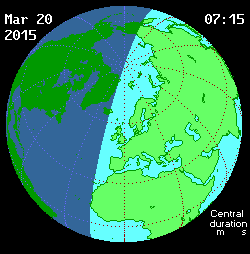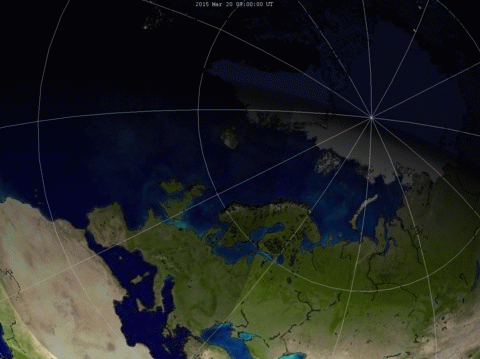Solar eclipse of March 20, 2015
| Solar eclipse of March 20, 2015 | |
|---|---|
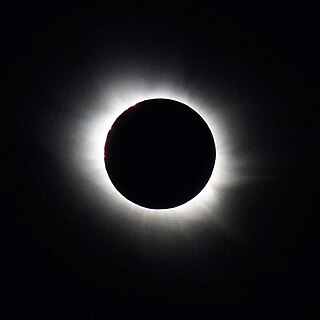 From Longyearbyen, Svalbard | |
| Type of eclipse | |
| Nature | Total |
| Gamma | 0.9454 |
| Magnitude | 1.0445 |
| Maximum eclipse | |
| Duration | 167 s (2 min 47 s) |
| Coordinates | 64°24′N 6°36′W / 64.4°N 6.6°W |
| Max. width of band | 463 km (288 mi) |
| Times (UTC) | |
| Greatest eclipse | 9:46:47 |
| References | |
| Saros | 120 (61 of 71) |
| Catalog # (SE5000) | 9541 |
A total solar eclipse will occur on Friday March 20, 2015. Template:Total solar eclipse summary
It will have a magnitude of 1.045. The longest duration of totality will be 2 minutes 47 seconds off the coast of the Faroe Islands. It is the last total solar eclipse visible in Europe until the eclipse of August 12, 2026. [1]
At the end of its path, the shadow of the Moon rises from the Earth's surface to space at the north pole. As March 20 is the Northward equinox, the eclipse occurs as the Sun rises at the north pole for the first time in six months.
Images
Closeup animation of shadow in 30 second frames:
Related eclipses
Lunar eclipses
A total lunar eclipse will follow on April 4, 2015, visible over Australia, and the Pacific coast of Asia and North America.
Solar eclipses 2015-2018
This eclipse is a member of a semester series. An eclipse in a semester series of solar eclipses repeats approximately every 177 days and 4 hours (a semester) at alternating nodes of the Moon's orbit.[2]
| Descending node | Ascending node | |||||
|---|---|---|---|---|---|---|
| Saros | Map | Gamma | Saros | Map | Gamma | |
120 Longyearbyen, Svalbard |
2015 March 20 Total |
0.94536 | 125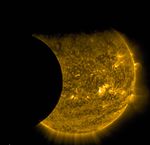 Solar Dynamics Observatory |
2015 September 13  Partial (south) |
−1.10039 | |
130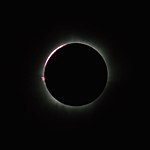 Balikpapan, Indonesia |
2016 March 9 Total |
0.26092 | 135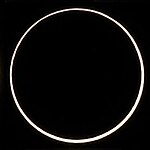 L'Étang-Salé, Réunion |
2016 September 1 Annular |
−0.33301 | |
140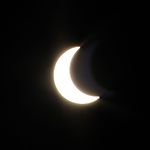 Partial from Buenos Aires |
2017 February 26 Annular |
−0.45780 | 145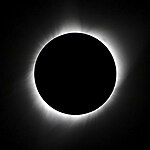 Casper, Wyoming |
2017 August 21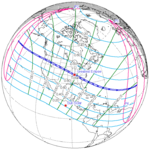 Total |
0.43671 | |
150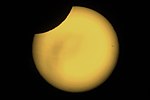 Partial from Olivos, Buenos Aires |
2018 February 15 Partial (south) |
−1.21163 | 155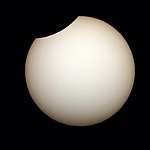 Partial from Huittinen, Finland |
2018 August 11 Partial (north) |
1.14758 | |
Partial solar eclipses on July 13, 2018, and January 6, 2019, occur during the next semester series.
Saros series
This eclipse is a part of Saros cycle 120, repeating every 18 years, 11 days, containing 71 events. The series started with partial solar eclipse on May 27, 933 AD, and reached an annular eclipse on August 11, 1059. It was a hybrid event for 3 dates: May 8, 1510, through May 29, 1546, and total eclipses from June 8, 1564, through March 30, 2033. The series ends at member 71 as a partial eclipse on July 7, 2195. The longest duration of totality was 2 minutes, 50 seconds on March 9, 1997. All eclipses in this series occurs at the Moon’s descending node.
| Series members 55–65 occur between 1901 and 2100 | ||
|---|---|---|
| 55 | 56 | 57 |
 January 14, 1907 |
 January 24, 1925 |
 February 4, 1943 |
| 58 | 59 | 60 |
 February 15, 1961 |
 February 26, 1979 |
 March 9, 1997 |
| 61 | 62 | 63 |
 March 20, 2015 |
 March 30, 2033 |
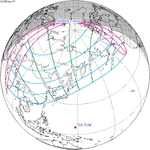 April 11, 2051 |
| 64 | 65 | |
 April 21, 2069 |
 May 2, 2087 | |
Metonic series
The metonic series repeats eclipses every 19 years (6939.69 days), lasting about 5 cycles. Eclipses occur in nearly the same calendar date. In addition, the octon subseries repeats 1/5 of that or every 3.8 years (1387.94 days). All eclipses in this table occur at the Moon's descending node.
| 21 eclipse events between June 1, 2011 and June 1, 2087 | ||||
|---|---|---|---|---|
| May 31 – June 1 | March 19–20 | January 5–6 | October 24–25 | August 12–13 |
| 118 | 120 | 122 | 124 | 126 |
 June 1, 2011 |
 March 20, 2015 |
 January 6, 2019 |
 October 25, 2022 |
 August 12, 2026 |
| 128 | 130 | 132 | 134 | 136 |
 June 1, 2030 |
 March 20, 2034 |
 January 5, 2038 |
 October 25, 2041 |
 August 12, 2045 |
| 138 | 140 | 142 | 144 | 146 |
 May 31, 2049 |
 March 20, 2053 |
 January 5, 2057 |
 October 24, 2060 |
 August 12, 2064 |
| 148 | 150 | 152 | 154 | 156 |
 May 31, 2068 |
 March 19, 2072 |
 January 6, 2076 |
 October 24, 2079 |
 August 13, 2083 |
| 158 | 160 | 162 | 164 | 166 |
 June 1, 2087 |
 October 24, 2098 |
|||
Notes
- ^ http://eclipse.gsfc.nasa.gov/SEsearch/SEsearchmap.php?Ecl=20260812[dead link]
- ^ van Gent, R.H. "Solar- and Lunar-Eclipse Predictions from Antiquity to the Present". A Catalogue of Eclipse Cycles. Utrecht University. Retrieved 6 October 2018.


